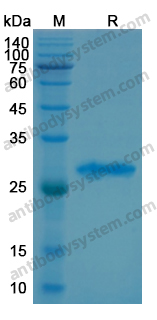Catalog No.
YHB32401
Expression system
E. coli
Species
Homo sapiens (Human)
Protein length
Met1-Gly226
Predicted molecular weight
26.74 kDa
Nature
Recombinant
Endotoxin level
Please contact with the lab for this information.
Purity
>90% as determined by SDS-PAGE.
Accession
O75832
Applications
ELISA, Immunogen, SDS-PAGE, WB, Bioactivity testing in progress
Form
Lyophilized
Storage buffer
Lyophilized from a solution in PBS pH 7.4, 0.02% NLS, 1mM EDTA, 4% Trehalose, 1% Mannitol.
Reconstitution
Reconstitute in sterile water for a stock solution. A copy of datasheet will be provided with the products, please refer to it for details.
Shipping
In general, proteins are provided as lyophilized powder/frozen liquid. They are shipped out with dry ice/blue ice unless customers require otherwise.
Stability and Storage
Use a manual defrost freezer and avoid repeated freeze thaw cycles. Store at 2 to 8°C for frequent use. Store at -20 to -80°C for twelve months from the date of receipt.
Alternative Names
26S proteasome non-ATPase regulatory subunit 10, 26S proteasome regulatory subunit p28, PSMD10, Gankyrin, p28(GANK)
Gankyrin Inhibition Can Control Helicobacter pylori Generated Gastric Cancer Using In Vivo Xenograft Models., PMID:40415180
Integration of ubiquitination-related genes in predictive signatures for prognosis and immunotherapy response in sarcoma., PMID:39469643
Structural modification of the propyl linker of cjoc42 in combination with sulfonate ester and triazole replacements for enhanced gankyrin binding and anti-proliferative activity., PMID:39029437
Immunomodulatory effects of a probiotic combination treatment to improve the survival of Pacific oyster (Crassostrea gigas) larvae against infection by Vibrio coralliilyticus., PMID:38650950
NOP16 promotes hepatocellular carcinoma progression and triggers EMT through the Keap1-Nrf2 signaling pathway., PMID:38251077
Withania somnifera extract reduces gastric cancerous properties through inhibition of gankyrin in cellular milieu produced by Helicobacter pylori and Epstein Barr virus., PMID:37655681
SERBP1 Promotes Stress Granule Clearance by Regulating 26S Proteasome Activity and G3BP1 Ubiquitination and Protects Male Germ Cells from Thermostimuli Damage., PMID:37223481
EBNA1 Upregulates P53-Inhibiting Genes in Burkitt's Lymphoma Cell Line., PMID:37131894
Identification of potential biomarkers and immune infiltration characteristics in recurrent implantation failure using bioinformatics analysis., PMID:36776897
Gankyrin-mediated interaction between cancer cells and tumor-associated macrophages facilitates prostate cancer progression and androgen deprivation therapy resistance., PMID:36776524
A New Insight Into p53-Inhibiting Genes in Epstein–Barr Virus-Associated Gastric Adenocarcinoma., PMID:36624687
Snapshots of urea-induced early structural changes and unfolding of an ankyrin repeat protein at atomic resolution., PMID:36382986
miR-188-5p and Host MALAT1 Regulate RBE Cell Migration, Invasion, and Apoptosis via Up-regulating PSMD10 in Cholangiocarcinoma., PMID:36121635
Hsa-miR-1248 suppressed the proliferation, invasion and migration of colorectal cancer cells via inhibiting PSMD10., PMID:36028821
Activating IL-6/STAT3 Enhances Protein Stability of Proteasome 20S α+β in Colorectal Cancer by miR-1254., PMID:35615012
Identification of Tumor-Suppressive miR-30e-3p Targets: Involvement of SERPINE1 in the Molecular Pathogenesis of Head and Neck Squamous Cell Carcinoma., PMID:35409173
Novel Nexus with NFκB, β-catenin, and RB1 empowers PSMD10/Gankyrin to counteract TNF-α induced apoptosis establishing its oncogenic role., PMID:35378311
A druggable pocket on PSMD10Gankyrin that can accommodate an interface peptide and doxorubicin., PMID:34953804
Prognostic and immune infiltration signatures of proteasome 26S subunit, non-ATPase (PSMD) family genes in breast cancer patients., PMID:34839279
Interaction between PSMD10 and GRP78 accelerates endoplasmic reticulum stress-mediated hepatic apoptosis induced by homocysteine., PMID:34666830
Helicobacter pylori and Epstein-Barr Virus Coinfection Stimulates Aggressiveness in Gastric Cancer through the Regulation of Gankyrin., PMID:34585958
Selenite Downregulates STAT3 Expression and Provokes Lymphocytosis in the Liver of Chronically Exposed Syrian Golden Hamsters., PMID:34577085
Identification of a quality-control factor that monitors failures during proteasome assembly., PMID:34446601
Genetically incorporated crosslinkers reveal NleE attenuates host autophagy dependent on PSMD10., PMID:34254583
The Silence of PSMC6 Inhibits Cell Growth and Metastasis in Lung Adenocarcinoma., PMID:34239933
Identification of novel gankyrin binding scaffolds by high throughput virtual screening., PMID:33865970
Structural Insights into Ankyrin Repeat-Containing Proteins and Their Influence in Ubiquitylation., PMID:33435370
Quantitative expression of Ikaros, IRF4, and PSMD10 proteins predicts survival in VRD-treated patients with multiple myeloma., PMID:33284947
Exploring gankyrin's role in cancer development and its potential as a therapeutic target., PMID:32892644
LINC00665 Promotes the Progression of Multiple Myeloma by Adsorbing miR-214-3p and Positively Regulating the Expression of PSMD10 and ASF1B., PMID:32764956
Optimizing the aryl-triazole of cjoc42 for enhanced gankyrin binding and anti-cancer activity., PMID:32738965
Inhibiting effect of MicroRNA-3619-5p/PSMD10 axis on liver cancer cell growth in vivo and in vitro., PMID:32437796
LncRNA DANCR Promotes Sorafenib Resistance via Activation of IL-6/STAT3 Signaling in Hepatocellular Carcinoma Cells., PMID:32103983
Blocking the autocrine regulatory loop of Gankyrin/STAT3/CCL24/CCR3 impairs the progression and pazopanib resistance of clear cell renal cell carcinoma., PMID:32051393
The lncRNA SNHG3 accelerates papillary thyroid carcinoma progression via the miR-214-3p/PSMD10 axis., PMID:32048306
Structural modification of the aryl sulfonate ester of cjoc42 for enhanced gankyrin binding and anti-cancer activity., PMID:31902711
Increased Expression of Gankyrin and Stemness Factor Oct-4 are Associated with Unfavorable Clinical Outcomes and Poor Benefit of Tamoxifen in Breast Carcinoma Patients., PMID:31853860
The oncogene Gankyrin is expressed in testicular cancer and contributes to cisplatin sensitivity in embryonal carcinoma cells., PMID:31744479
Gankyrin promotes osteosarcoma tumorigenesis by forming a positive feedback loop with YAP., PMID:31678253
The Oncoprotein Gankyrin/PSMD10 as a Target of Cancer Therapy., PMID:31576540
Molecular mechanisms linking peri-implantitis and type 2 diabetes mellitus revealed by transcriptomic analysis., PMID:31275749
The long non-coding RNA Linc-GALH promotes hepatocellular carcinoma metastasis via epigenetically regulating Gankyrin., PMID:30692513
Gankyrin is a novel biomarker for disease progression and prognosis of patients with renal cell carcinoma., PMID:30558998
Gankyrin drives metabolic reprogramming to promote tumorigenesis, metastasis and drug resistance through activating β-catenin/c-Myc signaling in human hepatocellular carcinoma., PMID:30503555
Gankyrin Contributes to Tumorigenesis and Chemoresistance in Sporadic Colorectal Cancer., PMID:30513515
Gankyrin Drives Malignant Transformation of Gastric Cancer and Alleviates Oxidative Stress via mTORC1 Activation., PMID:30420909
Long noncoding RNA NBAT1 inhibits autophagy via suppression of ATG7 in non-small cell lung cancer., PMID:30323972
miR-214 regulates papillary thyroid carcinoma cell proliferation and metastasis by targeting PSMD10., PMID:30272290
Chronic Microcystin-LR Exposure Induces Hepatocarcinogenesis via Increased Gankyrin in Vitro and in Vivo., PMID:30205410
KIFC1 regulated by miR-532-3p promotes epithelial-to-mesenchymal transition and metastasis of hepatocellular carcinoma via gankyrin/AKT signaling., PMID:30115976

